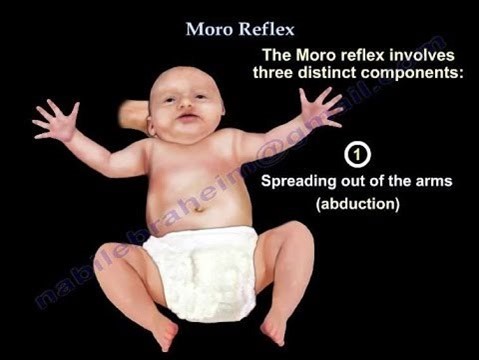A nurse in the newborn nursery is collecting data about a newborn's Moro reflex. Which of the following actions should the nurse take to elicit this reflex?
Turn the newborn's head quickly to one side while they are sleeping.
Place a finger in the newborn's palm.
Clap hands after laying the newborn on a flat surface.
Hold the newborn upright with one foot touching the crib surface.
The Correct Answer is C
To elicit the Moro reflex, the nurse should clap hands after laying the newborn on a flat surface. The Moro reflex, also known as the startle reflex, is an involuntary motor response that infants develop shortly after birth. Loud noises and sudden movements can trigger a baby’s Moro reflex.
Option a is incorrect because turning the newborn's head quickly to one side while they are sleeping may not elicit the Moro reflex.
Option b is incorrect because placing a finger in the newborn's palm may elicit the grasp reflex, not the Moro reflex.
Option d is incorrect because holding the newborn upright with one foot touching the crib surface may not elicit the Moro reflex.

Nursing Test Bank
Naxlex Comprehensive Predictor Exams
Related Questions
Correct Answer is A
Explanation
Keeping a baby rear-facing in the car seat until they reach the age of 2 years old or until they reach the maximum height and weight limits recommended by the car seat manufacturer is a crucial safety guideline. Rear-facing car seats provide better support for a baby's head, neck, and spine in the event of a crash, reducing the risk of severe injuries.
"I should place my baby in the car seat at a 90-degree angle." The correct positioning for a rear-facing car seat is typically between a 30 to 45-degree angle. This angle helps ensure the baby's airway remains open and prevents their head from flopping forward.
"I should position the car seat's retainer clip at the level of my baby's belly button." The retainer clip of the car seat should be positioned at armpit level, not at the level of the baby's belly button. The retainer clip is designed to secure the harness straps and should be placed across the chest, resting on the bony part of the shoulders.
"I should enable the airbag when my baby is in the front seat of the car." It is not safe to have a rear-facing car seat with a baby in the front seat of a vehicle with an active airbag. Airbags can pose a significant risk to infants due to the force with which they deploy. It is recommended to place a rear-facing car seat in the back seat of the vehicle and disable the airbag in the front passenger seat if the baby needs to ride in the front.
It is important for parents to receive proper education on car seat safety and follow the guidelines set forth by car seat manufacturers, national recommendations, and local laws and regulations.
Correct Answer is D
Explanation
Delayed gastric emptying can cause diarrhea in a client with a gastrostomy tube.
The other options are not likely causes of diarrhea.
a) A slow formula infusion rate (option would not cause diarrhea.
b) Giving formula immediately following removal from the refrigerator (option b) may cause discomfort but not diarrhea.
c) A partially obstructed feeding tube (option c) would slow down the infusion rate and would not cause diarrhea.
Whether you are a student looking to ace your exams or a practicing nurse seeking to enhance your expertise , our nursing education contents will empower you with the confidence and competence to make a difference in the lives of patients and become a respected leader in the healthcare field.
Visit Naxlex, invest in your future and unlock endless possibilities with our unparalleled nursing education contents today
Report Wrong Answer on the Current Question
Do you disagree with the answer? If yes, what is your expected answer? Explain.
Kindly be descriptive with the issue you are facing.
